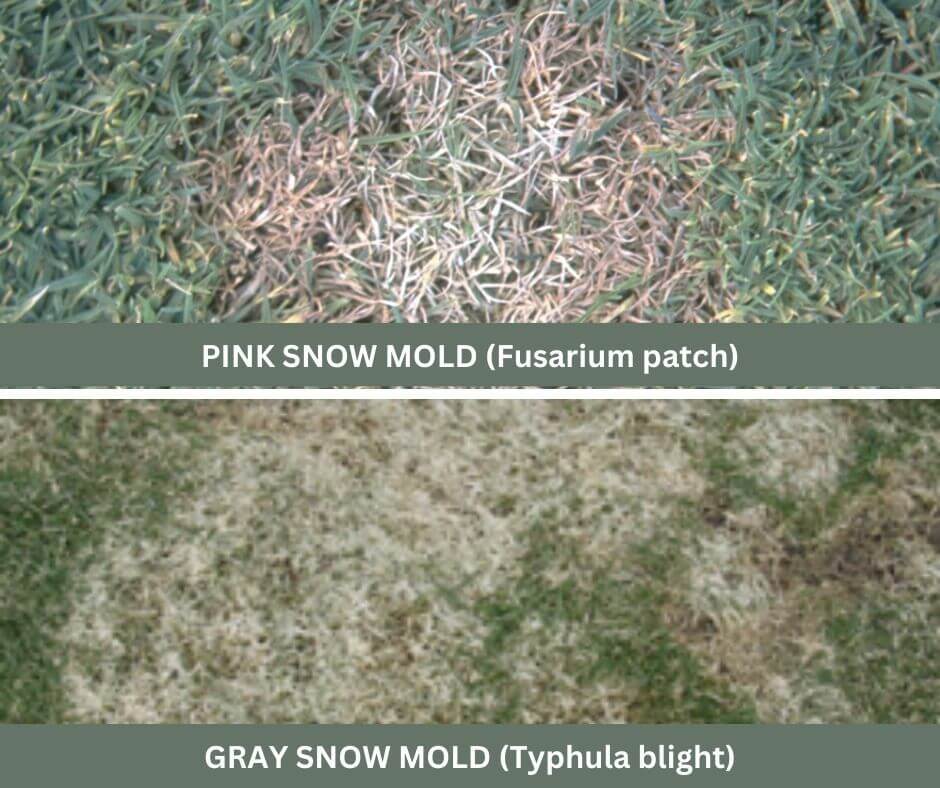As the winter snow recedes, homeowners often encounter an unexpected and unsightly problem in their lawns: snow mold. This common lawn issue, characterized by pink or gray patches of damaged grass, can significantly impact the health and appearance of your lawn. Understanding the types, causes, and effective management strategies for snow mold is crucial for maintaining a lush and vibrant landscape.
Understanding Snow Mold: Types and Causes
 Snow mold appears in two main forms: pink snow mold (Fusarium patch) and gray snow mold (Typhula blight). Pink snow mold is more damaging, as it can kill the crown and roots of grass plants, while gray snow mold usually affects only the blades of the grass. The development of snow mold is primarily fostered by prolonged snow cover on unfrozen ground, creating a moist and cold environment conducive for the growth of these fungi.
Snow mold appears in two main forms: pink snow mold (Fusarium patch) and gray snow mold (Typhula blight). Pink snow mold is more damaging, as it can kill the crown and roots of grass plants, while gray snow mold usually affects only the blades of the grass. The development of snow mold is primarily fostered by prolonged snow cover on unfrozen ground, creating a moist and cold environment conducive for the growth of these fungi.
Environmental factors play a significant role in the development of snow mold. Early snowfalls that trap moisture in the grass, a thick layer of thatch, and inadequate lawn drainage can all contribute to the proliferation of snow mold. Fallen leaves and long grass left over the winter can also create a layer of organic matter that provides an ideal breeding ground for the fungus.
Preventative Measures for Snow Mold
Preventing snow mold starts with good lawn maintenance practices in the fall. Keeping your lawn at an optimal height, generally between 2 to 3 inches, is important as longer grass can harbor moisture and create a favorable environment for mold growth. Fall lawn cleanup, including the removal of excess thatch, leaves, and other debris, is essential in preventing the conditions that snow mold thrives in.
Fertilization in the late summer or early fall can help strengthen grass roots, making them more resilient to mold. However, it’s important to avoid over-fertilizing, as excessive nitrogen can encourage snow mold growth. Aerating the lawn in the fall can also help by improving soil drainage and reducing compaction, thereby discouraging mold development. In areas prone to snow mold, applying a preventative fungicide before the first heavy snowfall can provide an additional layer of protection.
Identification and Immediate Treatment Steps
Identifying snow mold involves inspecting your lawn as the snow melts for any pink or gray circular patches. These patches are typically matted down and can vary in size. Once identified, immediate action is necessary to prevent further damage. Gently raking affected areas helps to loosen matted grass, allowing air and sunlight to reach the soil and facilitate drying. This simple step can often be enough to kickstart the recovery process for your lawn.
While it might be tempting to apply fungicides to affected areas, they are generally not recommended for already damaged lawns. The grass is often capable of recovering on its own with proper care and maintenance, and fungicides can sometimes do more harm than good in these situations.
Recovery and Lawn Restoration Post-Snow Mold
After initial treatment, the focus shifts to lawn recovery and restoration. This involves reseeding any dead patches to encourage new growth. It’s important to select a grass seed that is appropriate for your region and soil type. Nurturing new grass growth involves regular watering and appropriate fertilization to ensure strong development.
While fungicides are not recommended post-infection, preventive measures for the following year can be planned. These include maintaining good lawn health throughout the growing season, continuing with regular mowing, and applying a balanced fertilizer regime. Proper lawn care throughout the year can significantly reduce the likelihood of snow mold reoccurring.
Safeguarding Your Lawn for Future Winters
Snow mold, while a common post-winter lawn problem, can be effectively managed with the right knowledge and care. Understanding the types and causes of snow mold, implementing preventive measures, and taking prompt action at the first signs of an outbreak are key to maintaining a healthy lawn. By being proactive and attentive to lawn care, homeowners can ensure their lawns remain vibrant and snow mold-free, year after year.